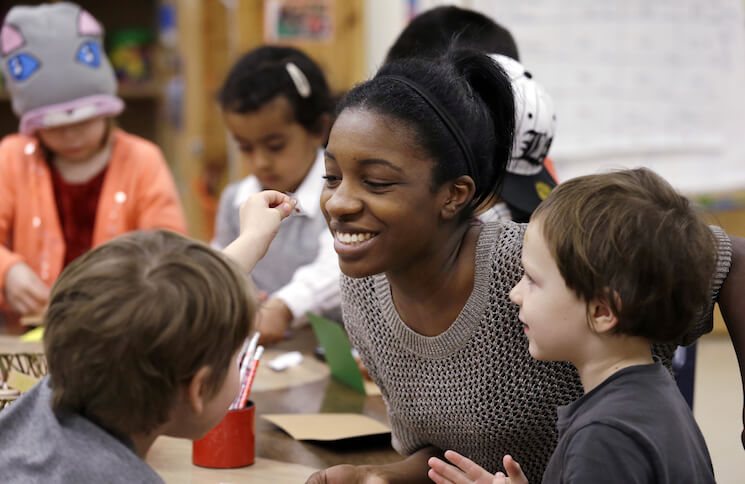Sustaining preschool gains can help the benefits of early childhood education endure

Preschool’s promise to close achievement gaps and reduce educational inequalities in the United States is facing renewed challenges. New research continues to show that the cognitive benefits of early childhood education programs appear to diminish by primary school, especially in programs that target children from low-income families.
Yet there are several issues with assessing only the medium-term outcomes from attending preschool—issues that demonstrate that these fade-out arguments insufficiently account for other measurements and determinants of success. What’s more, these results instead indicate there is a mismatch in our educational system that prevents many kids from sustaining the undeniable early gains from a preschool education. To address this mismatch, researchers and policymakers are also looking to new ways to encourage continuity and consistency in early education.
In a recent essay for The Washington Post, Drew Bailey and Greg Duncan of University of California-Irvine and Candice Odgers of Duke University add to the commentary on fade-out. Using data on literacy and math achievement from close to 70 high-quality prekindergarten programs targeted toward low- and lower-middle income families, the researchers find short-term boosts from preschool participation, followed by a quick dissipation of the gains. The meta-analysis of cognitive skills by the end of the programs shows that within one year of attending an early childhood education program, the effect sizes across programs were halved, and by two years, they were halved again.
These patterns of narrowing cognitive achievement gaps between prekindergarten-goers and non-participants have been documented by others, too, but often fail to consider the non-cognitive skills built by early childhood education—skills such as grit or problem solving that in combination with cognitive skills help determine life-long success. Bailey, Duncan, and Odgers do acknowledge that the long-term benefits of early childhood education interventions—such as reduced grade retention rates, improved college enrollment, and increased adult earnings—justify investments in preschool. They note, though, that “it’s also a mistake to expect that initial gains will sustain themselves.”
Sure enough, sustaining the gains remains an important conversation among early childhood education researchers and practitioners alike. While there are many different ways to extend the cognitive (and even non-cognitive) rewards of attending high-quality preschool, there seems to be consensus that improving the transition to kindergarten and the quality of kindergarten and primary school programs is vital.
A smooth transition from a high-quality prekindergarten program to kindergarten and, later, primary school can positively impact a student’s educational outcomes. Yet the current synergy between high-quality preschool and elementary schools may not allow for consistency of experience. In response to this observation, some experts suggest focusing on aligning efforts between prekindergarten programs through third grade to create seamless transitions through instruction, curriculum, and even tests.
This movement, known as P-3, is still in its early phases, but results from programs around the country are beginning to trickle in. One such study, conducted by the RAND Corporation researchers Gail Zellman and M. Rebecca Killburn, evaluated Hawaii’s P-20 Partnerships for Education’s P-3 state program across five sites. The program itself focuses on improving the literacy outcomes for students by third grade, with the hope that program participants are all reading at grade level by then.
Zellman and Killburn find that since the program’s start in 2009, students’ reading scores increased statistically significantly while exposure to the P-3 program improved their chances of receiving a proficient on the statewide reading test by third grade. Even though Hawaii’s P-3 program showed moderate success by third grade, there is still much to learn about the long-term effects of an aligned curriculum. Time will ultimately help reveal whether P-3 is an effective way to address the fade-out of cognitive skills, but in the meantime its potential for reducing achievement gaps is encouraging.
The responsibility to help sustain the gains cannot just be placed on educational institutions. There are a variety of factors that influence children’s long-term outcomes aside from prekindergarten and primary school, including what happens at home. And considering that educational achievement gaps between young children from high- and lower-income families may be mirroring widening income-based gaps in non-school learning activities, families’ engagement with their young children is equally important to early development and learning.
Recent research by Equitable Growth grantee and University of Chicago professor Ariel Kalil, New York University’s Kathleen M. Ziol-Guest, Georgetown University’s Rebecca M. Ryan, and University of Virginia’s Anna J. Markowitz shows that while lower-income families are increasingly owning children’s books or visiting the library, the income-based differences between parental actions, such as reading to children, teaching words and numbers, and other daily cognitively-based activities, and cultural activities, such as museum or zoo visits, are growing.
The four scholars’ findings indicate that lower-income families may require more support to be able to engage with their children to complement classroom-based learning. Models such as the Nurse-Family Partnership or the parent outreach and engagement components of the Chicago Child-Parent Center can serve as templates for how to strengthen parent involvement in early childhood education. But to help ensure the benefits of prekindergarten endure, more strategies and resources for lower-income families are needed.
Academics and policymakers do not have all the answers to how to reduce preschool fade-out or sustain the gains made in early childhood education programs. But through coordinated efforts at school and at home, they may get one step closer to closing achievement gaps, reducing educational inequalities, and ultimately fulfilling preschool’s promise. After all, if successful, these investments will only bolster the academic, individual, familial, and societal outcomes that promote broad-based and more equitable economic growth.
